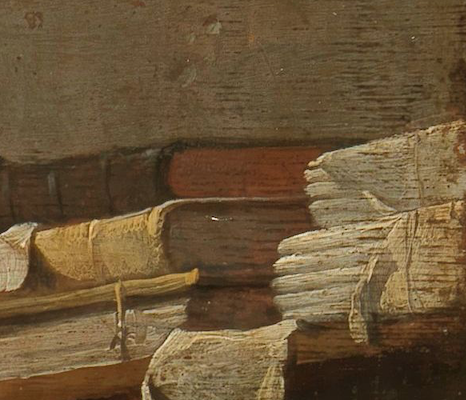
Early Modern Europe was a paper age - a first period of paper usages. Especially managing information became a paper business as the painting "The Lawyer's Office" (1628) from Pieter de Bloot @rijksmuseum t1p.de/1awb highlights. A meta thread for #paperhistory.
1/x
1/x

As I have highlighted in earlier threads like this one (
2/x
https://twitter.com/dbellingradt/status/1326477938171195393), paper was from the fourteenth century onwards increasingly being used for more and more communication flows. Hello inky paper states and letter writing humans, here comes the printing industry.
2/x
The artifact paper became more and more present in Europe, for example in schools as I have shed light on here:
And the demand grew and grew and grew. More paper was used, for writing, for printing, and for wrapping purposes.
3/x
https://twitter.com/dbellingradt/status/1343560867741376512
And the demand grew and grew and grew. More paper was used, for writing, for printing, and for wrapping purposes.
3/x
What we call the book culture, was a paper wrestling and consuming activity of writing, printing, reading, and storing paper. Blank sheets, printed books, small prints, it was all part of a new material culture of paper flows.
Have a look:
4/x
Have a look:
https://twitter.com/dbellingradt/status/1356866904972013569
4/x
Some of these characteristic paper flows can seen on the painting from 1628: you see record keeping practices, writing, folding, storing of papers, waste papers lying around, and books waiting to be used. Entering a lawyer's office was walking into a paper space.
5/x
5/x

Let's start with the waste papers lying around at the floor. paper was being used, and often thrown away after usage. Wherever paper was used, waste paper could also be found.
6/x
6/x

These pieces of a paper sheets give us a hint to the material life of hand-made paper in early modern Europe: it was produced, it was used, and it was recycled - often to fresh 'new' paper. And there is a quill lying next to the paper. Maybe a frustrated writer?
7/x
7/x

Paper broadsides or broadsheets glued to the walls or furniture were not uncommon. In a lawyer's office they often announced things, or explained service prices or gave other advise. The two in the painting seem to be carrying script, printed words on paper. A poster world.
8/x
8/x

Writing is an information managing practice, not only in a secretary world. The highlighted persons are writing for money, in big books and on paper sheets (drafts, letters). They needed training for their texts, and certain materials: ink, pen or quill, and lots of papers.
9/x
9/x

Using papers had consequences. Where to store a record-keeping business like a lawyer's office? This office decided, like many secretaries and lawyer at the time, to use document bags - literally filled with paper. These bags hang also in administration buildings.
10/x
10/x

Well, this is not a perfectly organized shelf. You see paper waiting, old and new alike, bound books, smaller paper sheets, unbound books. Storing paper was tricky.
11/x

11/x


Let's focus on the next paper mess on the painting. You see bound paper books surrounded by loose sheets of different qualities and formats, you see a bundle of letters, you see layers of papers in a floating hierachy. Storing loose papers was messy.
12/x

12/x


Paper needed to be purchased in great numbers and regularly, especially offices like the one in the painting needed steadily incoming paper flows. And these paper flows of fresh sheets, as will be shown soon, came from the paper trade. Have a look:
13/x
https://twitter.com/dbellingradt/status/1346077209237327872
13/x
The incoming paper flows to offices came in units of the paper trade: from single sheet to, for example, reams of about 500 sheets. These fresh sheets came in dozens of different qualities and formats, and you had to order wisely. Some of these fresh sheets can be seen here.
14/x
14/x

Let's focus on the fresh reams and sheets waiting (next to old papers and bound books). You see two reams here, covered with ream wrappers, and you see the sheets being folded to get them transported.
15/x
15/x

Fresh sheets needed storage spaces, and sometimes the fresh sheets were just waiting and temporarily stored on the writing desk. Secretary work in a lawyer's office was often fast, and paper needed to be handy, as highligted here:
16/x
https://twitter.com/dbellingradt/status/1375465156562583554
16/x
This is another example of waiting fresh sheets, folded after manufacture for transport purposes. These sheets seem almost forgotten on the shelf. Poor papers.
17/x
17/x

Old books had their reselling markets, as indicated here, for example:
But what happened with all these early modern papers beside printed books? While some were being recycled most old papers were used for wrapping purposes.
18/18. The End.
https://twitter.com/dbellingradt/status/1336325211856113666.
But what happened with all these early modern papers beside printed books? While some were being recycled most old papers were used for wrapping purposes.
18/18. The End.
• • •
Missing some Tweet in this thread? You can try to
force a refresh





















